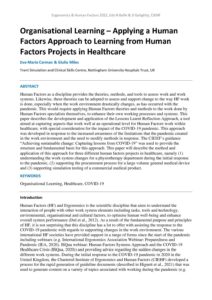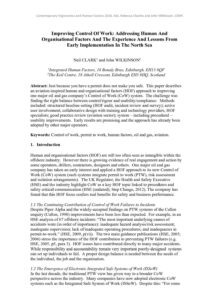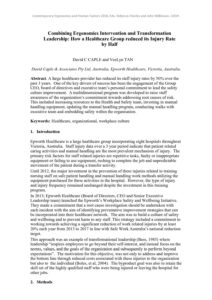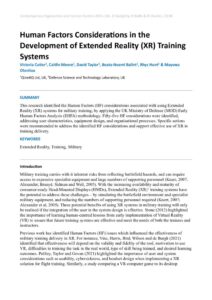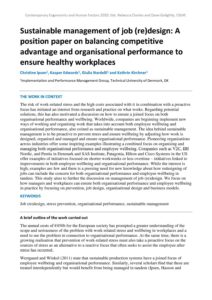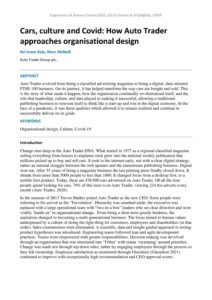Organisational design
Organisational Learning – Applying a Human Factors Approach to Learning from Human Factors Projects in Healthcare
| Document | Author Eva-Maria Carman & Giulia Miles |
| Abstract Human Factors as a discipline provides the theories, methods, and tools to assess work and work systems. Likewise, these theories can be adopted to assess and support change to the way HF work is done, especially when the work environment drastically changes, as has occurred with the pandemic. This would require applying Human Factors theories and methods to the work done by Human Factors specialists themselves, to enhance their own working processes and systems. This paper describes the development and application of the Lessons Learnt Reflection Approach, a tool aimed at capturing aspects that work well at an operational level for Human Factors work within healthcare, with special consideration for the impact of the COVID-19 pandemic. This approach was developed in response to the increased awareness of the limitations that the pandemic created in the work environment and the need to modify methods in response. The CIEHF’s guidance “Achieving sustainable change: Capturing lessons from COVID-19” was used to provide the structure and fundamental basis for this approach. This paper will describe the method and application of this approach for three different human factors projects in healthcare, namely (1) understanding the work system changes for a physiotherapy department during the initial response to the pandemic, (2) supporting the procurement process for a large volume general medical device and (3) supporting simulation testing of a commercial medical product. |
Improving Control Of Work: Addressing Human And Organisational Factors And The Experience And Lessons From Early Implementation In The North Sea
| Document | Author Neil CLARK and John WILKINSON |
| Abstract Just because you have a permit does not make you safe. This paper describes an aviation-inspired human and organisational factors (HOF) approach to improving one major oil and gas company’s Control of Work (CoW) system. The challenge was finding the right balance between control/rigour and usability/compliance. Methods included: structured baseline setting (HOF audit, incident review and survey); active user involvement; collaborative design with training and technology providers, HOF specialists; good practice review (aviation sector); system – including procedural – usability improvements. Early results are promising and the approach has already been adopted by other major operators. |
Combining Ergonomics Intervention and Transformation Leadership: How a Healthcare Group reduced its Injury Rate by Half
| Document | Author David C CAPLE and VeeLyn TAN |
| Abstract A large healthcare provider has reduced its staff injury rates by 50% over the past 3 years. One of the key drivers of success has been the engagement of the Group CEO, board of directives and executive team’s personal commitment to lead the safety culture improvement. A multidimensional program was developed to raise staff awareness of the organization’s commitment towards addressing root causes of risk. This included increasing resources to the Health and Safety team, investing in manual handling equipment, updating the manual handling program, conducting walks with executive team and embedding safety within the organisation. |
Human Factors Considerations in the Development of Extended Reality (XR) Training System
| Document | Author Victoria Cutler, Caitlin Moore, David Taylo, Beata-Noemi Balint, Rhys Hunt & Mayowa Olonilua |
| Abstract This research identified the Human Factors (HF) considerations associated with using Extended Reality (XR) systems for military training, by applying the UK Ministry of Defence (MOD) Early Human Factors Analysis (EHFA) methodology. Fifty-five HF considerations were identified, addressing user characteristics, equipment design, and organisational processes. Specific actions were recommended to address the identified HF considerations and support effective use of XR in training delivery. |
Sustainable management of job (re)design: A position paper on balancing competitive advantage and organisational performance to ensure healthy workplaces
| Document | Author Christine Ipsen, Kasper Edwards, Giulia Nardelli and Kathrin Kirchner |
| Abstract The risk of work-related stress and the high costs associated with it in combination with a proactive focus has initiated an interest from research and practice on what works. Regarding potential solutions, this has also motivated a discussion on how to ensure a joined focus on both organisational performance and wellbeing. Worldwide, companies are beginning implement new ways of working and organising work that takes into account both employee wellbeing and organisational performance, also coined as sustainable management. The idea behind sustainable management is to be proactive to prevent stress and ensure wellbeing by adjusting how work is designed, organised and managed and ensure organisational performance. Pioneering organisations across industries offer some inspiring examples illustrating a combined focus on organising and managing both organisational performance and employee wellbeing. Companies such as V2C, IIH Nordic, and Pentia in Denmark and SAS Institute, Patagonia, Hilton and Cisco Systems in the US offer examples of initiatives focused on shorter workweeks or less overtime – initiatives linked to improvements in both employee wellbeing and organisational performance. While the interest is high, examples are few and there is a pressing need for new knowledge about how redesigning of jobs can include the concern for both organisational performance and employee wellbeing in tandem. This study aims to further the discussion on management of job (re)design. We focus on how managers and workplaces can ensure both organisational performance and employee wellbeing in practice by focusing on prevention, job design, organisational design and business models. |
Cars, culture and Covid: How Auto Trader approaches organisational design
| Document | Author Nu’maan Kala, Marc McNeill |
| Abstract Auto Trader evolved from being a classified advertising magazine to being a digital, data oriented FTSE 100 business. On its journey, it has helped transform the way cars are bought and sold. This is the story of what made it happen; how the organisation continually revolutionised itself, and the role that leadership, culture, and data played in making it successful; allowing a traditional publishing business to reinvent itself to think like a start-up and win in the digital economy. In the face of a pandemic, it was these qualities which allowed it to remain resilient and continue to successfully deliver on its goals. |
Human and organisational factors in cybersecurity: applying STAMP to explore vulnerabilities
| Document | Author Andrew Wright, Gyuchan Thomas Jun |
| Abstract The human and organisational factors contributing to information security are still poorly understood, primarily due to a lack of research and absence of suitable techniques to assess complex digital systems. This paper presents the application of the System-Theoretic Accident Models and Process (STAMP) technique to the 2013/2014 Target Corporation data breach. The aims of the study are to investigate the causal factors using a systemic approach, and to demonstrate the benefits of the technique to information security applications. A number of critical control flaws were identified through the STAMP analysis include: i) poor external and internal communication/co-ordination of new threats and vulnerabilities; ii) inadequate learning from past events, internally and externally; iii) a lack of proactive security management to understand and learn from system successes and good practices as well as system failures; iv) ineffective management and co-ordination with the supply chain. |

